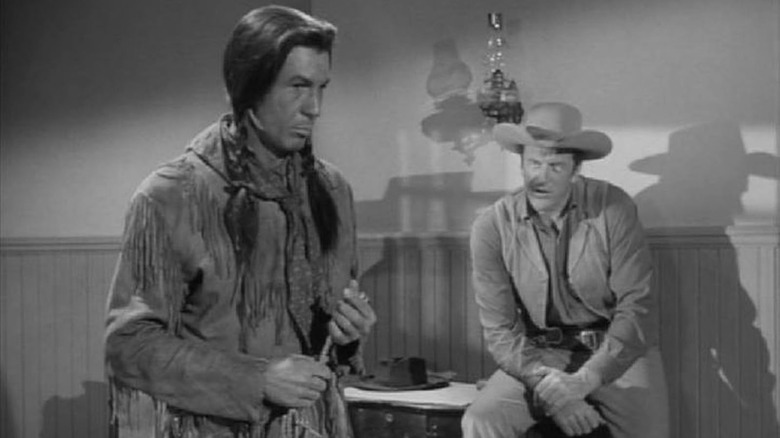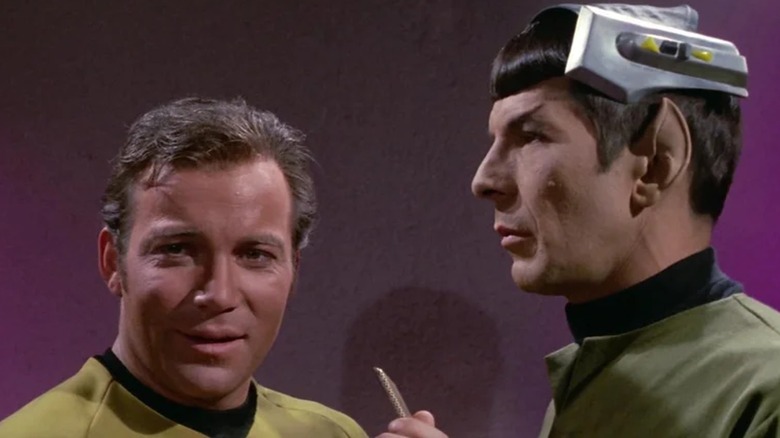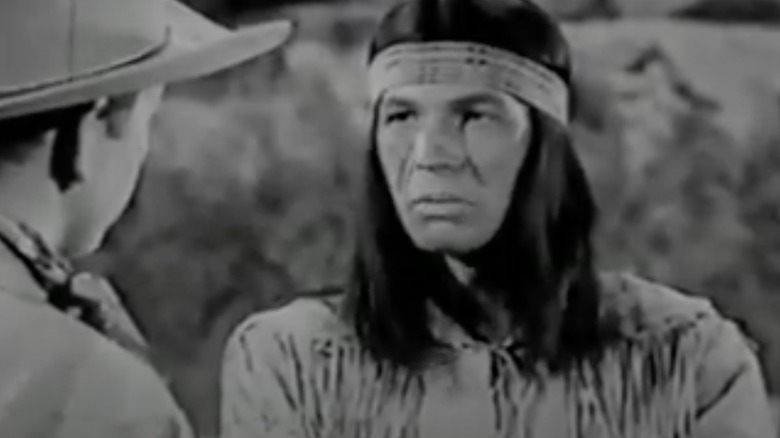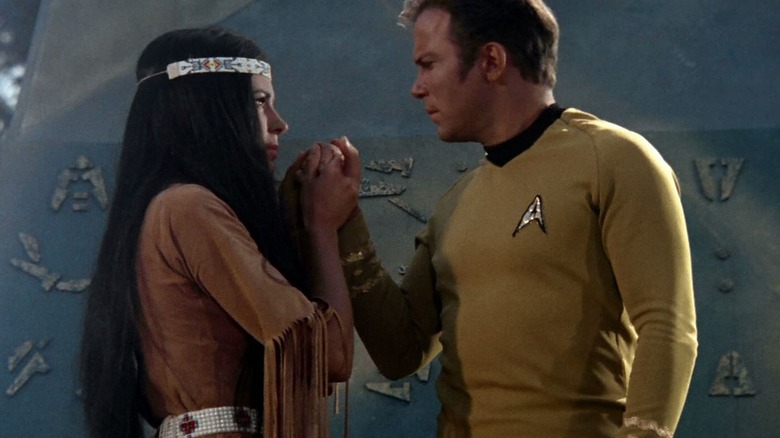Leonard Nimoy was one of the beloved TV actors of the twentieth century, however he additionally admitted in interviews through the years that –- regardless of rising up the Jewish son of Ukrainian immigrants –- he made his profession within the pre-“Star Trek” days taking part in Native American characters. Amongst different cases of “redface,” he performed a Comanche warrior within the TV present “Tate,” a personality named Chief Black Hawk within the movie “Outdated Overland Path,” and a mysterious Native who seeks justice for his murdered white good friend in an episode of the wildly common present “Gunsmoke.”
Nimoy spoke fondly about his position on “Gunsmoke” in an interview with the Archive of American Tv again in 2000 (he handed away in 2015). The actor recalled having met the star of the long-running Western sequence, James Arness, years earlier when the 2 had been in the identical appearing troupe. Nimoy ultimately went into the army, however saved in contact with Arness, who in the future instructed him he’d landed the lead position within the TV adaptation of a well-liked radio present –- “Gunsmoke.” Nimoy appeared a number of instances on the present through the years, nevertheless it was his closing look in 1966 that was most memorable to him … and most controversial at the moment.
“A visitor starring position within the Gunsmoke present was the final job I did simply earlier than I began taking pictures ‘Star Trek,'” Nimoy defined within the retrospective interview. “I had already accomplished the ‘Star Trek’ pilot and I used to be employed for this story –- taking part in an Indian.” Particularly, Nimoy performed a person named John Strolling Fox, who acquired his personal episode title in season 11: “The Treasure of John Strolling Fox.” Nimoy as soon as instructed PBS that he did the present whereas he was ready to listen to about whether or not or not “Star Trek” was going to lastly get picked up after failed pilots, and complimented the episode’s “intelligent” script by Clyde Ware. With a long time of retrospect, although, the story would not sound intelligent a lot as misguided and responsible of racial stereotyping.
Nimoy performed mysterious Native American John Strolling Fox
“The story, as I recall, was about an Indian fur trapper, excellent mates with a white man who additionally did the identical factor they usually typically went trapping collectively,” Nimoy instructed the TV Archive. The white man was ultimately killed in a confrontation with a dealer, and per the actor, “there was one thing about, there wasn’t going to be any justice for this good friend of John Strolling Fox.” The Indigenous character saved the day by paying for his good friend’s funeral in gold, finally orchestrating infighting among the many city’s criminals (together with his good friend’s killer) by pretending to have gold treasure. The killer was ultimately killed within the squabble over John’s treasure. “There isn’t a treasure, however he constructed this story,” Nimoy stated. “So it is sort of a wry manner of getting some social justice.”
Social justice is an ironic time period to make use of right here, as loads of Native American activists had been already preventing for recognition and fairness within the Sixties, all whereas non-Native folks had been taking part in cartoonish variations of them on TV. Nimoy instructed PBS that “the character [of John Walking Fox] was designed to be enigmatic,” and shared some qualities with “Star Trek” hero Spock. This, in fact, performs into stereotypes of the mysterious, stoic Native that had been rampant throughout the Western style on the time (for extra on this and each different subject mentioned right here, watch the good documentary “Reel Injun”). The John Strolling Fox episode is not notably stunning, however the way in which Nimoy spoke about being typecast as a Native American kind of is. “I had performed some Indians earlier than, however I believe that is crucial Indian position I had ever been given,” Nimoy instructed PBS within the 2010s. “Most of them weren’t fairly so consequential.”
The actor had a troubling manner of discussing his Indigenous roles
You’ll assume that a long time of retrospect would have led Nimoy to raised perceive why talking about taking Native American roles as if he is in search of higher ethnic illustration on display can be deceptive, nevertheless it appears the actor by no means got here to that realization. In Abigail Pobegrin’s ebook “Stars of David,” Nimoy talked much more callously about being typecast in a racial position that did not match him (per The Atlantic). “Guys like me had been taking part in all of the ethnic roles, normally the heavies — the unhealthy Mexicans, the unhealthy Italians,” Nimoy defined. “And people had been the roles that I took and was pleased to get for a very long time. I performed Indians in Westerns many instances.”
Disturbingly, Nimoy even claimed within the ebook that the primary Native position he took was “a task {that a} Native Indian turned down as a result of the Indian character was so unredeemably unhealthy.” However he wasn’t involved in regards to the poor illustration as a result of, as he put it, “I used to be pleased to get the work, thanks very a lot.” It is a heartbreaking, infuriating story introduced as one thing lighthearted. It is heartbreaking as a result of it sounds just like the writers behind the challenge in query ignored the legitimate considerations of the Native actor they initially supplied the challenge to, as a substitute opting to only hold the script the identical and provides the job to a non-Native man. It is infuriating as a result of Nimoy additionally positioned the unnamed Native actor as ungrateful for what he had been given, fairly than courageous for standing up in opposition to dangerous, reductive stereotypes that dominated the business on the time. Primarily, this story is every thing that was improper with twentieth century Native American portrayals in Hollywood in a nutshell.
Hollywood barely forged Native American actors for many years
I want there was a “however” on the finish of this story or some kind of come-to-Jesus second that this deeply beloved and proficient actor had later in life through which he realized that he was actively blocking Native actors from getting roles. If there may be, it isn’t in any interview I’ve discovered; Nimoy was nonetheless talking positively about nabbing Native roles to PBS just some years earlier than his dying. The actor was culpable for his personal actions, however he was additionally one piece of a bigger racist system. In Arlene B. Hirschfelder and Martha Kreipe de Montaño’s 1998 ebook “The Native American Almanac: A Portrait of Native America At the moment,” the authors embody an intensive but incomplete record of non-Native actors who took Native roles. “Absolutely no group has ever been misrepresented in so many films for thus lengthy,” they wrote. “Many Indians really feel that in casting, Native actors have occupied a single area of interest as a result of, till lately, Indians normally weren’t forged to play Indians. Bankable non-Indian stars acquired main Indian roles.”
Nimoy’s title is, in fact, on the record. However “Gunsmoke” appears to mark one of many final instances the actor performed a Native American on display. “Star Trek” took off quickly after and made him a family title, and his behavior of taking over Indigenous roles with impunity turned a factor of the previous. In 2011, the actor joked to the Wall Road Journal that the transition from one pigeonholed position to the opposite made sense. He labored on Westerns, “more often than not taking part in Indians,” he instructed the outlet. “[So,] naturally, after I acquired into science fiction, I needed to play an alien.” Yeesh.





